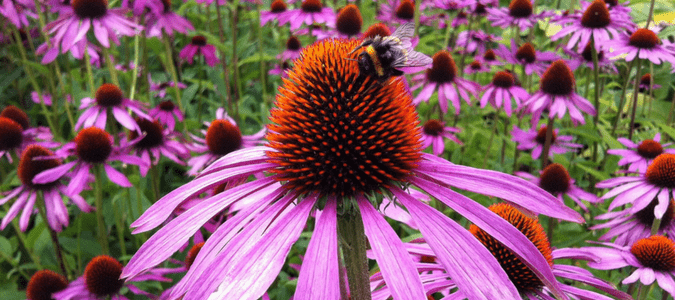
A rite of passage here in Texas is taking the family for the annual Bluebonnet photo. Did you know these plants are just the tip of the iceberg for wildflowers in Texas? And you can grow these flowers in your back (or front) yard?
Whether you’re tired of the usual suspects in your home garden or considering wildflowers as another way to use native plants in your landscaping, wildflowers are a gorgeous option that can add a nice splash of color to any property.
Below, we will suggest different types of purple Texas wildflowers you might consider incorporating in your lawn and answer common questions homeowners have about adding these plants to your outdoor spaces.
Different Types of Purple Wildflowers You Can Find in Texas
Bluebonnets and Indian paintbrushes get the lion’s share of attention when it comes to Texas wildflowers, but they’ve got nothing on the many varieties of purple wildflowers that thrive in our state. Here are our suggestions for some of the most beautiful species that grow in our warm climate.
Beach False Foxglove
With numerous buds that pop out side-by-side up the stem and petals that resemble cups at the bottom that branch out at the top, these flowers are unique and beautiful.
Downy Indian Paintbrush
These tall plants with petals resembling a butterfly’s shape can be a beautiful change of pace if you’re interested in adding some vertical beauty to your space.
Giant Spiderwort
Perfect for East Texas landscapes, these deep purple flowers each have three petals and grow in bunches.
Goldeneye Phlox
While the most common color for these flowers is pink, they also come in blue, red, and–that’s right–purple. With their white and yellow center, the effect can be striking and add much to any landscape.
Lindheimer’s Milkvetch
Talk about unique. Like many of the flowers on this list, the buds of the Milkvetch grow in clusters. However, it’s usually pretty easy to tell where the individual buds are on those plants. With the Milkvetch, they are arranged so that when they bloom, the petals of multiple buds create a single design–a burst of purple and white that may form the shape of a cross or diamond, a triangle, or more. If you want something different for your space, this is it.
Purple Coneflowers
Some describe their petals as purple. Others as hot pink. We say they’re purple enough to warrant featuring on this list. With their long drooping petals and orange-brown center, these flowers make a stunning addition to any lawn.
Purple Gerardia
The overlapping purple petals resemble fan blades that form little circles of color.
Purple Milkweed
This plant is characterized by clusters of buds that open to create little circular bursts of purple. While milkweed is excellent for attracting butterflies to your yard, ensure no little ones or pets are around to eat them because they’re poisonous.
Prairie Verbena
Can you say adorable? These purple flowers of this variety of gerardia grow in tight clusters and feature bright, tiny petals.
Winecup
As the name implies, the color of these flowers is closer to the deep reddish-purple of a glass of red wine. With their long stem and petals that seem to be reaching up towards the sun, winecups are an excellent way to add a touch of elegance to your yard.
Woolly Locoweed
This plant presents as a rounded green clump at the bottom, with numerous stems reaching up that each contains clusters of purple petals.
These aren’t the only purple wildflowers in our state. There are so many that we can’t fit them all into one list. For a complete list, check out the Wildflower Center’s database.
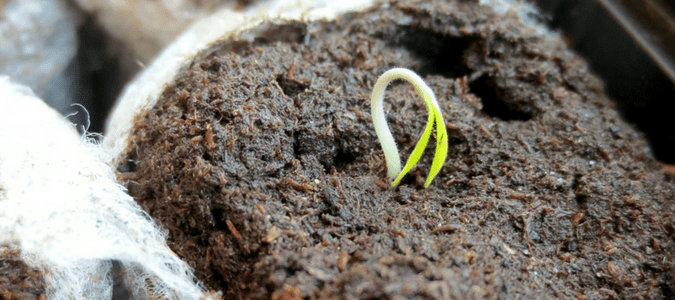
How Long Does It Take for Wildflowers to Grow in Texas?
Unfortunately, there isn’t a simple answer to how long a wildflower takes to grow from a seed into a stunning pop of color. As you might imagine (and may have discovered from your gardening), different flowers have different life cycles. Some are longer. Some are shorter. Some take forever to get started. Others bloom more quickly.
For specific information about individual types of purple wildflowers, the best thing to do is go straight to the professionals and ask about the particular flowers you’re thinking about growing. Since this is a general guide with so many flowers, we can’t give you exact time frames.
That doesn’t stop us from telling you about the general growth period of Texas wildflowers, though. With this information, you’ll at least know what you’re getting into before you take the next step.
So, how long does it generally take Texas wildflowers to grow?
Germination
When it comes to wildflowers, here are some general rules of thumb:
- Many seeds will germinate within 10-20 days of you planting them.
- Some only germinate in early spring. However, that doesn’t mean you can’t plant other flowers in the fall or winter.
- Late summer or early fall is the ideal time to plant most wildflowers.
Life Cycle
A wildflower’s life cycle can give you additional insight into how long it will take to mature. Keep these things in mind:
- Native perennials typically have a lifecycle of at least two years.
- You might notice sprouts the first year, but you won’t see blooms until year two or three.
That’s right. This is a project that’s going to take a while before you get to enjoy the fruits of your labor, and that’s incredibly important to know going in.
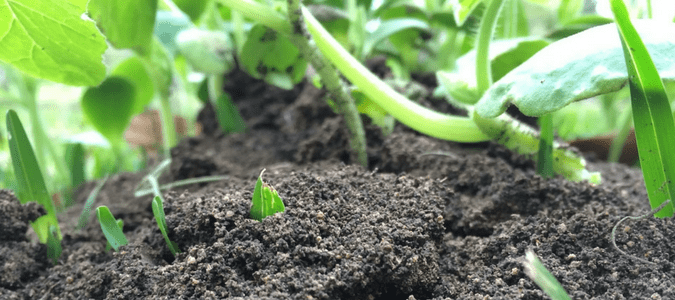
How to Plant Wildflowers in Grass
Otherwise known as “meadow planting,” growing wildflowers in the grass can help you turn your landscape into a sea of color and beauty if you do it right.
This starts with making sure you’re using suitable wildflowers for your region (the state of Texas alone does span four hardiness zones, after all!). Also, native grasses should ideally form between 50 and 80 percent of your meadow because they will help protect your wildflowers and ensure their growth.
Once you’ve selected the suitable plant species for your area, your next step is to prepare the soil. In most cases, preparing the soil means giving the grassy area a close mow. To germinate, the seeds need to be able to contact the soil. To further increase the likelihood of germination, TxDOT recommends dragging something heavy over the sowed area: “a weighted section of chain link fence or other rough flat object” should do the trick.
If you’re worried about the soil not having enough nutrients, it’s okay to use a low-nitrogen fertilizer when you plant the seeds to boost your seeds. Make sure you stop after that because fertilizing established wildflowers will result in more foliage and fewer blooms–probably not what you want.
After planting, give the seeds a nice, long watering, but don’t blast the area with a hard spray. You want the seeds to stay where they are and sink in. Gentle is the way to go. Follow this initial long watering with shorter waterings every three days for the first three weeks.
By this time, most wildflowers will have germinated. Your job at that point mostly becomes waiting and hoping.
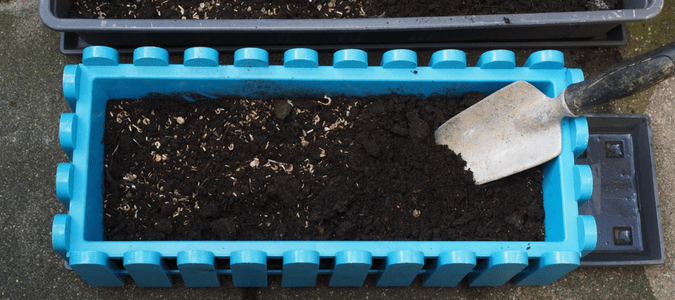
How to Grow Wildflowers in Pots
Lacking in space? Hoping to add color and natural beauty to the interior of your property?
Good news. You can quickly grow the native wildflowers you love in pots and other containers, and it’s fairly similar to how you would grow non-native plants.
Here are the basic steps:
- Get your pot or container.
- Add potting soil.
- Plant like seeds together. This isn’t strictly required but can make things easier in the early going. Once your plants grow, mixing and matching won’t have as much effect, provided you choose wisely.
- Add the seeds or grown plants. Just like with meadow planting, wildflower seeds need to make contact with the soil. For actual plants, however, you will need to dig a hole to place them in.
- Regardless of whether you plant seeds or plants, they need more water in the beginning, then less once they are established. That being said, potted plants generally require more watering than outdoor plants.
- Ensure you put your containers in an area with full sunlight.
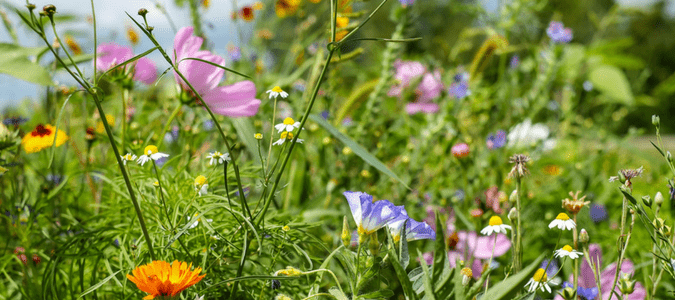
Planting Wildflowers in Gardens
Many rules and steps for adding wildflowers to your garden are the same as planting them in grass or pots. The big difference here is aesthetic. When you have a lot of plants together in a smaller area like a garden, it becomes more important to think about how they will look together in terms of height and color.
In other words, choose wisely.
Beyond that, many experienced growers prefer to sow native seeds indoors in flats before transplanting them to the garden when ready.
Additionally, whereas with meadow growing, you can be a lot more hands-off, you’ll want to treat garden wildflowers more like exotic annuals. Remove them from your flower bed when they get ragged or fade.
ABC Can Incorporate Wildflowers Into Your Landscape
Growing Texas wildflowers isn’t hard–figuring out which plants will be the best to grow in your area, pairing the right plants with each other, and knowing how many seeds to use per square foot. Although there are guides on how to do this, much of the information is surprisingly complicated. Count on the experts at ABC Home & Commercial Services to help you create a beautiful native landscape. With our help, you can sit back and enjoy the final result without lifting a finger.